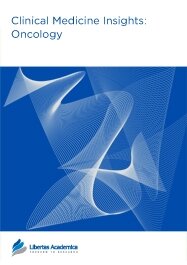

Publication Date: 09 Feb 2012
Type: Original Research
Journal: Clinical Medicine Insights: Oncology
doi: 10.4137/CMO.S9005

Background: The present study investigated tumor proliferation in a tumor model using murine ovarian cancer cells with increased carbonyl reductase (CR) expression.
Methods: CR cDNA was transfected into murine T-Ag-MOSE ovarian cancer cells by lipofection. CR-transfected cells (CR induction group) or empty vector-treated cells (control group) were injected into the backs of 8-week-old nude mice at a concentration of 0.5 × 106 per 0.2 mL. Subsequent tumor proliferation in both groups was observed for 5 weeks.
Results: The control group showed an increase in tumor volume during the 5 weeks of observation. However, tumor volume in the CR induction group increased up to the second week but then decreased continuously until the fifth week of observation. The tumor growth curves for the two groups showed a significant difference (Mann-Whitney U test, P < 0.001). Histological and biochemical experiments were performed using tumor tissues isolated in the third week. Necrosis and inflammatory cell infiltration were noted for tumors in the CR induction group. Also, the number of apoptotic cells was significantly increased in the CR induction group compared with the control group (P < 0.001). Milk fat globule EGF factor 8, an “eat-me” signal for phagocytes such as macrophages, was expressed extensively in the tumor cytoplasm and interstitial cells of the CR induction group, and engulfment of apoptotic cells by macrophages was observed. Vascular endothelial growth factor expression in tumors was notably decreased in the CR induction group compared with the control group.
Conclusion: Increased necrosis due to engulfing of apoptotic cells by phagocytes attracted by increased milk fat globule EGF factor 8 was considered to be the mechanism of spontaneous tumor regression in the CR induction group.
PDF (4.83 MB PDF FORMAT)
RIS citation (ENDNOTE, REFERENCE MANAGER, PROCITE, REFWORKS)
BibTex citation (BIBDESK, LATEX)
XML
PMC HTML

The team at Libertas Academica stands above the pack as publishers of academic journals. My recent article in Clinical Medicine Insights: Oncology was handled very professionally throughout the process. They have my highest regards.

All authors are surveyed after their articles are published. Authors are asked to rate their experience in a variety of areas, and their responses help us to monitor our performance. Presented here are their responses in some key areas. No 'poor' or 'very poor' responses were received; these are represented in the 'other' category.See Our Results
Copyright © 2013 Libertas Academica Ltd (except open access articles and accompanying metadata and supplementary files.)
FacebookGoogle+Twitter
PinterestTumblrYouTube